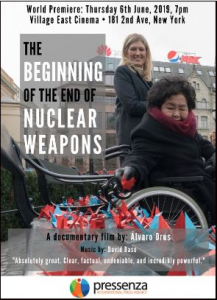
On November 21, 2019 the Marrickville Peace Group (MPG) held a public screening of two documentary films on the threat to human survival posed by nuclear weapons.
The first film shown was “The Beginning of the End of Nuclear Weapons”. This feature-length documentary focuses on the history of nuclear weapons as well as the anti-nuclear movement that has campaigned to bring a nuclear weapons ban treaty into international law.
The later part of the film is based on interviews with leading activists from many different organisations and countries, including those associated with the International Campaign to Abolish Nuclear Weapons (ICAN). The documentary reveals the key co-ordinating role that ICAN played in promoting the humanitarian initiative that successfully challenged the dominant nuclear security narrative. This initiative culminated in 122 states voting in favour of the Treaty on the Prohibition of Nuclear Weapons (TPNW) at the United Nations on July 7, 2017.1
The second film shown was “My Fish is Your Fish”. This short documentary, produced by the Marshall Islands Student Association (MISA) based at the University of the South Pacific in Suva, Fiji, outlines the lasting impact of nuclear weapons testing on the Marshall Islands and its people. Informed by interviews with survivors, it highlights the work of MISA in educating young people, in particular, across the Pacific region about the adverse nuclear legacy in the Marshall Islands.
The documentaries were introduced by Peter Griffin from MPG. In addition, Gem Romuld from ICAN spoke about the importance of persuading nations to endorse the TPNW. In order to come into effect, TPNW needs to be ratified by at least 50 states. As of 25 November 2019, TPNW has been signed by 80 states, while 34 states have proceeded to ratify it.2
Gem also spoke about the progress made in Australia to gain support for the TPNW. This includes almost 200 parliamentarians from all parliaments that have signed the ICAN Parliamentary Pledge as well as:
- A commitment from the federal Labor Party to sign and ratify the TPNW if in government;
- Resolutions of support from Labor Party branches in WA, NT, SA, VIC, ACT and TAS;
- The backing to date of 25 local councils including the Inner West Council.
It should also be noted that the Greens have consistently supported the TPNW.
During the Q&A session following the screenings, Gem outlined ICAN’s response to claims that Australia would be obligated to repudiate its military alliance with the United States if it ratified the TPNW. According to ICAN’s assessment, if Australia became party to the TPNW, it would have to renounce its nuclear umbrella arrangement with the United States. However ICAN asserts that Australia can do so without undermining its military alliance with the United States which is founded on the ANZUS Treaty.
A contrary view contends that the integration of Australian and US defense systems, exemplified by the joint Australian-US military facility at Pine Gap and the incorporation of US extended nuclear deterrence in Australia’s national security policies, constitutes too many logistical challenges to unravel. If so, for the pro-TPNW campaign to succeed, it would also need to support Australia developing an independent foreign policy devoid of any links to joint Australian-US facilities and defense activities involving nuclear weapons systems.
So far successive Coalition Governments since September 2017 have refused to sign the TPNW. However, as the campaign’s momentum grows, ratification of TPNW may well become a prominent issue in the lead up to the next Australian federal election due to take place in or before 2022.
In addition, it is very likely that a majority of members of Pacific Islands Forum, of which Australia is a member, will ratify the TPNW in the next couple of years.3 This growing regional support will help amplify calls for Australia to ratify the treaty and contribute to ending the existential threat posed by nuclear weapons.4
Notes
1. The text of the Treaty on the Prohibition of Nuclear Weapons (TPNW) can be found here. A record of the vote on the treaty can be viewed here.
2. The TPNW opened for signature at United Nations headquarters in New York on 20 September 2017. Current information on the signature and ratification status of the treaty can be accessed here.
3. A list of full and associate member states of the Pacific Islands Forum who have signed or ratified the TPNW can be found here.
4. It should be noted that Australia has ratified the South Pacific Nuclear Free Zone Treaty, commonly referred to as the Treaty of Rarotonga. This treaty formalises a Nuclear-Weapon-Free Zone in the South Pacific. The treaty came into force on 11 December 1986 the bans the use, testing, and possession of nuclear weapons within the borders of the zone.